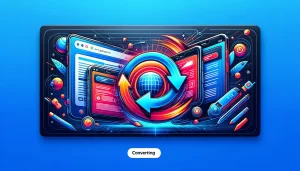For those embarking on the app development journey, discerning the most suitable type of app for your business can pose a challenge. Rest assured; many individuals have grappled with this decision in the past.
In this comprehensive guide, we aim to give you a thorough understanding of progressive web apps (PWAs) and native apps. Furthermore, we will scrutinize the advantages and disadvantages of PWAs vs native apps. This facilitates an informed decision-making process tailored to your specific needs and preferences. However, before delving into the discourse surrounding “PWA vs. native mobile app,” it is imperative to establish a clear comprehension. This includes understanding both application types.
Understanding Progressive Web Applications
A progressive web application, commonly known as a PWA, diverges from the traditional format we are accustomed to. Instead, it presents itself as a website meticulously designed and optimized to emulate the functionality of a mobile app. In essence, Progressive Web Apps offer a more user-friendly experience than standard web pages without requiring downloads from app stores. Users access them through their web browser, enabling immediate usage. To further elucidate this concept, consider the mobile websites for Spotify or Starbucks, which are exemplary instances of showcasing PWAs.
What exactly is a Native Application?
The term “React native” is quite straightforward. It refers to an application purposefully developed to function flawlessly on a specific platform, whether iOS or Android. This tailored approach ensures seamless adaptability and delivers a superior user experience. Whether you develop for Android or iOS, your application will possess a codebase that cannot be shared across various platforms. A quintessential illustration of native apps can readily be found on your device. Examples include the pre-installed calculator or weather application.
PWAs vs. Native Apps: A Comprehensive Comparison
Now, let’s explore the fundamental differences between Progressive Web Apps (PWAs) and React Native apps to determine which option may be more suitable.
Development Cost and Time
A primary factor driving businesses towards PWAs is the cost and time associated with their development. Creating a PWA is typically more cost-effective than building a react native app, and the development process is relatively quicker. PWAs are constructed using web technologies that developers are already familiar with, and they can be easily deployed across multiple platforms.
User Experience
Native apps offer a more refined and polished user experience than PWAs. They are meticulously designed to leverage the device’s hardware and software capabilities, ensuring a seamless and highly responsive user experience. In contrast, PWAs are limited to web browser capabilities and may not provide the same level of responsiveness as native apps.
Accessibility
PWAs hold an accessibility advantage over Native App since they can be accessed on any device equipped with a web browser. In contrast, native apps are platform-specific and require users to download and install them before usage. This distinction implies that PWAs have the potential to reach a broader audience than native apps.
Maintenance and Updates
In general, maintaining and updating a PWA is a simpler process compared to a native app. PWAs allow for server-side updates, enabling users to access the latest version of the app without the need to download and install anything. In contrast, native apps require users to go through the process of downloading and installing updates, which can be more cumbersome.
PWAs vs Native Apps for Business: Which is the Better Option?
Progressive web apps (PWAs) and native apps offer distinct advantages and drawbacks, and deciding to develop one over the other for your business is contingent on various factors. Here are key factors to consider helping you make an informed choice:
Time to Market
In the early stages of development, prioritizing swift deployment or aiming to gather initial traction may steer you towards progressive web apps (PWAs).
Native apps require separate development teams for iOS and Android App Development. Furthermore, the approval process from app stores often proves lengthier than expected.
In contrast, PWAs can be developed and released quickly as they function as websites. This allows for rapid creation and launch to gather valuable market insights and user feedback. Additionally, bypassing app store validation eliminates the waiting period for launching and distributing native apps through platforms like Google’s Play Store and Apple’s App Store.
Development Cost
Native apps incur higher development costs because each platform requires separate versions to achieve genuine native functionality.
For Android app development, Java or Kotlin are typically used, while Objective-C or Swift is employed for iOS app development. These distinct programming languages require different development tech stacks, necessitating larger teams and increased costs. Furthermore, maintaining separate codebases for each platform leads to ongoing high-maintenance expenses. This substantial cost can present a significant hurdle for early-stage startups seeking initial user traction and feedback.
Conversely, building PWAs is more cost-effective and straightforward, as they function essentially as web apps designed to replicate the native app experience on any mobile device, irrespective of the platform.
Cross-platform Availability
When aiming to reach a broader audience or your target demographic spans different platforms, developing a native app exclusively for either Android or iOS may prove insufficient. To connect with customers and provide an optimal mobile experience, separate apps for both platforms must be created and maintained, which can be time-consuming and resource-intensive.
However, progressive web apps (PWAs) are designed to be responsive, simplifying and speeding up user engagement regardless of the chosen platform.
Here are some compelling reasons why PWAs have the potential to significantly enhance engagement rates:
- PWAs possess universal appeal and accessibility, making them attractive to a wider user base.
- Hulu, for example, experienced a remarkable 27% increase in returning visitors when transitioning from platform-specific experiences to PWAs.
- Nikkei witnessed a threefold increase in organic traffic and a 50% growth in daily users upon launching PWAs.
- Forbes achieved a 100% growth in engagement rates following the introduction of its PWA.
These success stories underscore the capacity of PWAs to greatly boost user engagement and reach, regardless of the platform.
PWAs vs Native Apps from an End-User Perspective: Which is Better?
The role of your users is crucial in determining the success and expansion of your business. Therefore, the choice between a progressive web application (PWA) and a native app should also be assessed from the viewpoint of the end-users. Let’s compare both options from the user’s standpoint:
Download & Installation
Mobile users highly value simplicity and ease of use. Only some people desire to undergo the hassle of app installation, particularly for tasks involving information acquisition or occasional use. Many users seek quick solutions while on the go. Additionally, with increasing concerns about privacy, users often hesitate to grant permissions to native apps, such as access to their phone’s storage or location.
In this context, PWAs offer a distinct advantage. Users aren’t compelled to install a PWA to access information, interact with a business, or make a purchase, as is often required with native mobile apps.
Progressive web apps excel in ease and convenience. They eliminate the need for installation, saving users time and conserving storage space on their devices. Functioning as hybrid apps, PWAs are readily accessible to iOS and Android users.
Performance
Progressive web apps (PWAs) are renowned for their fast-loading times, but they operate within a third-party browser, potentially leading to latency and significant battery consumption.
On the contrary, native apps seamlessly integrate into the smartphone environment once installed. They can leverage hardware and device features more efficiently than PWAs. Furthermore, native mobile applications deliver superior performance due to their platform-specific code, making them more robust.
Features & Functionalities
Native apps offer more features and functionalities than progressive web applications. Features such as geofencing, NFC-based mobile payments, inter-app communication, and smart sensor utilization perform more effectively in native apps.
Additionally, delivering push notifications on iOS devices is not feasible through a PWA; a native app is necessary for this functionality. Therefore, if you aim to utilize push notifications or any of the mentioned features, opting for native apps would be more suitable.
Offline Availability
PWAs can provide offline functionality by caching specific portions of the web app. However, they have limitations regarding offering information or features outside the natural caching system. In simpler terms, static app pages can be viewed offline, but submitting a form may only be possible once an internet connection is re-established.
In contrast, native apps excel in this aspect, providing a consistent experience, including access to information and offline functionality, even when users are not continuously connected to the internet.
The Difference Between PWAs vs Native Apps: For Developers
Native apps are specifically coded to operate on mobile devices, while PWAs are designed to function within a web browser. Native apps are built using platform-specific programming languages, such as Objective-C and Swift for iOS and Java for Android. In contrast, PWAs are developed using web technologies like HTML, CSS, and JavaScript.
Cost of development: Lower cost for PWA
Developing a progressive web app (PWA) is typically more cost-effective than creating a native app. Native app development involves learning platform-specific languages and building separate versions for iOS and Android. This means you’ll need at least two distinct versions, along with the resources to maintain and update each one. Depending on the app’s purpose and complexity, this can be a time-consuming and costly endeavor.
In contrast, PWAs offer a quicker development and update process. You can use a single codebase that can be deployed on various platforms, not limited to just the two major ones. Instead of starting from scratch, you can adapt your existing website using tools like Google Lighthouse. With responsive design, a single version of the app will display consistently across all devices, reducing development and maintenance overhead.
Distribution: PWA takes the cake for convenience
With native apps, in addition to developing separate versions for different platforms, you must also submit them to various app stores. Apple’s App Store and Android’s Play Store are the most well-known, but there are others like Amazon’s Appstore and the Windows Store, among others. Each of these stores has specific requirements that must be met before your app can be published. Sometimes, you may even need to pay a fee to register a developer account.
On the contrary, PWAs bypass the cumbersome App Store requirements. Users only need a web browser and a URL to access them. Many PWA features are supported by popular browsers like Chrome, Safari, Firefox, and Edge. This simplifies the process of reaching a large audience quickly. You can deploy updates without waiting for approval, making PWAs more convenient for both you and your users.
However, it’s worth noting that web stores have their merits. Their requirements help prevent low-quality apps from being published, which can enhance your app’s reliability and give users more confidence in accessing it through an app store rather than a URL link. Additionally, being featured in an app store can provide a quick boost to your branding and sales, promoting your business effectively.
Discoverability: ASO for native app and SEO for PWA
Native app pages cannot be indexed and listed in search engines. Users can only find your app through the app store or the app store’s website. App discoverability depends on various factors, and you can enhance your app’s visibility through App Store Optimization (ASO).
ASO is the process of improving your ranking in store search results. It involves tasks like keyword research, crafting an effective title and meta description, creating compelling screenshots, selecting relevant categorizations, and seeking downloads and reviews from third parties. However, all of these activities add extra time and cost to the process of launching your app in the market.
In contrast, PWAs function like regular websites, making them indexable by search engines. Compared to standard responsive web pages, PWAs offer enhanced performance and user engagement, which can lead to improved search engine rankings for your website.
To ensure that your PWA is SEO-friendly, consider implementing the following steps:
Mirror Your SEO Structure:
Create an SEO structure for your PWA that closely resembles that of your website. This consistency helps search engines understand your content better.
Utilize rel=canonical:
When dealing with multiple URLs, use the “rel=canonical” tag to indicate the preferred URL to avoid issues with duplicate content in search engine rankings.
Handle URLs with “#” Carefully:
Be cautious with URLs containing the “#” symbol, as Googlebot may not index anything after it. Ensure that critical content is placed before the “#” symbol in your URLs.
Monitor Googlebot Activity:
Use tools like Google Search Console to monitor how Googlebot is crawling and indexing your PWA. This allows you to identify and resolve any issues that may affect your site’s search engine visibility.
By following these additional steps, you can enhance the SEO-friendliness of your PWA and improve its chances of ranking well in search engine results.
Security: More security options in native apps
PWAs offer enhanced security compared to regular web apps because they must run under HTTPS. This security protocol ensures that all exchanges between the client and the server remain unaltered. In a secure environment, users can confidently input personal details and credit card information, knowing that their data is protected from potential theft or tampering.
In contrast, native apps provide the option to implement a wide range of security measures. For instance, if your app requires user login, you can incorporate Multi-Factor Authentication for added security. Additionally, you can employ Certificate pinning to further bolster secure communication. Furthermore, users often place more trust in an app than a URL because apps must meet stringent security requirements set by app stores before being published, further enhancing user confidence in their security.
Progressive Web Apps pros and cons
Here is an overview of the primary advantages and disadvantages associated with Progressive Web Apps (PWAs) that you should take into consideration.
Advantages of Progressive Web Apps:
- Cost-Efficiency: PWAs are a cost-effective option because they demand less development time and are simpler to maintain, leading to reduced development expenses compared to native apps.
- Speed and Responsiveness: PWAs deliver fast loading times and a seamless user experience by utilizing service worker technology, which enables offline functionality and caching.
- Cross-Platform Compatibility: PWAs adhere to web standards and are accessible on all devices and browsers, including desktop computers, mobile devices, and tablets.
- Reduced Storage Requirements: PWAs occupy less storage space on a device compared to native apps.
- SEO-Friendly: PWAs can be indexed by search engines just like regular websites, enhancing their visibility on search engine results pages (SERPs).
- Enhanced Security: PWAs maintain high security standards by adhering to HTTPS protocols and encrypting transmitted information.
Disadvantages of Progressive Web Apps:
- Limited Access to Native Device Features: PWAs may not have access to all the features available on a user’s device, including push notifications, camera functionality, and accelerometers.
- Limited Discoverability: PWAs are not as widely available on app stores such as Google Play or the Apple App Store, potentially limiting their discoverability by users.
- Security Risks: PWAs can be vulnerable to cyberattacks and may necessitate additional security measures to safeguard user data effectively.
- Limited User Engagement: PWAs may not achieve the same level of user engagement as native apps, especially in terms of social sharing and user-generated content.
These are the key points to consider when evaluating the benefits and drawbacks of Progressive Web Apps.
Native apps pros and cons
Similar to PWAs, native apps have their own set of advantages and disadvantages. Here’s an overview:
Advantages of Native Apps
- Fast and Efficient: Native apps are designed specifically for the platform they run on, making them faster and more efficient compared to web apps.
- Enhanced User Experience: They offer an improved user experience by fully utilizing the device’s features and hardware capabilities.
- High Performance: Native apps can function offline, ensuring superior performance and stability even without an internet connection.
- Offline Functionality: They can utilize push notifications and provide offline data storage, enhancing user engagement and convenience.
- Discoverability: Native apps can be easily discovered and installed by users from app stores, simplifying the accessibility process.
Disadvantages of Native Apps:
- Slower Time to Market (TTM): Native apps require more time and resources for development, as separate versions are needed for each platform (e.g., iOS and Android).
- Frequent Updates: Native apps must be updated and maintained independently for each platform, increasing the workload for developers.
- Higher Development Cost: The development cost of native apps is typically higher compared to web apps due to the need for platform-specific development.
- Lengthy Installation Process: Users need to download and install native apps, which can act as a barrier to entry for some potential users.
These factors should be taken into consideration when deciding whether to develop a native app or explore alternative options like Progressive Web Apps (PWAs).
Progressive web apps: Use cases
Let’s take a quick look at the various use cases of Progressive Web Apps (PWAs):
Offline Mode:
PWAs excel in offline scenarios, making them a perfect choice for users on the go or those with limited internet access. PWAs can save user data and allow seamless app usage even without a stable internet connection.
News and Media:
News and media companies benefit from PWAs to provide a speedy and responsive mobile experience. Notable examples include Forbes, Medium, and others in the industry.
Travel and Hospitality:
PWAs enhance the travel experience by offering real-time updates on travel information, such as flight status, gate changes, and delays. Prominent names in this sector include Trivago, Make My Trip, and Ola.
Banking and Finance:
PWAs are well-suited for banking and finance companies, enabling users to access their accounts, check balances, and make payments. Notable examples include payment systems like PayPal and Stripe.
Health and Fitness:
Health and fitness companies can leverage PWAs to provide interactive and personalized experiences. PWAs can offer workout plans, track user progress, and deliver tailored tips and advice. Prominent apps in this category include Fitbit, Headspace, and Nike Training Club, among others.
These diverse use cases highlight the versatility and advantages of Progressive Web Apps across various industries.
Native apps: Use cases
Certainly, here are the use cases of native apps across various domains:
E-commerce:
Native apps are frequently utilized by e-commerce businesses, enabling customers to make purchases directly from their mobile devices. Notable examples include Amazon, eBay, and similar platforms.
Social Media:
Popular social media platforms such as Facebook, Instagram, and Twitter are native apps that provide users with easy access to content sharing and engagement on their mobile devices.
Gaming:
Native apps are a prevalent choice for gaming, featuring popular titles like Candy Crush, Clash of Clans, and Angry Birds, offering immersive gaming experiences.
Education:
Educational institutions often deploy native apps, allowing students to access course materials, communicate with instructors, and manage their academic endeavors. Notable apps in this category include Duolingo, Minecraft Education Edition, and Photomath.
Productivity:
Native apps are employed to enhance productivity, offering tools like Microsoft Office, Evernote, and Trello that assist users in managing tasks, creating documents, and organizing their work efficiently.
Entertainment:
Native apps serve as primary platforms for entertainment purposes, hosting streaming services like Netflix, Hulu, and Disney+, providing users with access to a wide range of multimedia content.
These diverse use cases demonstrate the versatility and effectiveness of native apps in catering to specific needs across various industries and user preferences.
PWAs vs Native App: Which One Should You Choose?
Both Progressive Web Apps (PWAs) and Native Apps have the capacity to address a wide spectrum of business requirements. In Australia, where the market is diverse and tech-savvy, the choice between PWA and React Native should be driven by your target audience and app objectives. Nevertheless, before reaching a decision between the two, it is imperative to assess your available resources and maximize your time and financial resources.
When Should You Contemplate Utilizing a PWA?
Progressive Web Apps (PWAs) offer a compelling choice for numerous businesses, particularly those aiming to deliver a seamless user experience to their users. Now that you have a grasp of what a PWA entails, it becomes essential to ponder the scenarios in which adopting a PWA can prove advantageous. Below are situations where the adoption of a PWA should be considered:
Limited resources for a native app
In cases where you run an eCommerce website and aspire to enhance customer engagement and retention but are confronted with resource constraints, developing and maintaining multiple apps for various app stores may not be viable. In such circumstances, a PWA represents an ideal solution.
Emphasis on discoverability
PWAs obviate the need for the protracted process of submitting an app to diverse app stores. All that is required is a readily shareable website URL, enhancing discoverability among users.
Minimal storage requirements
Given that PWAs do not necessitate installation, they consume significantly less storage space on users’ devices. This makes them particularly appealing to businesses that wish to avoid burdening their customers with hefty app downloads.
Cost-effective development
Developing a native app can be a costly endeavor, especially if multiple platform-specific versions need to be created. PWAs present a more budget-friendly alternative, as they entail the creation of a single web-based app capable of functioning seamlessly across various platforms.
Cross-platform compatibility
PWAs, being web-based, offer compatibility across diverse platforms and devices, encompassing desktops, mobiles, and tablets. This renders them an excellent choice for businesses striving to deliver a uniform user experience across a range of devices.
When Should You Consider a Native App?
Consider opting for a native application if your product is intricate and necessitates greater control over a user’s mobile device. Examples of such applications encompass banking, social media, and dating apps, all of which demand consistent performance and user satisfaction. Native apps also stand as the preferred choice for high-security applications that manage sensitive client data, particularly in industries such as finance and healthcare. Below are some scenarios in which employing a native app is most appropriate:
Enhancing Brand Reputation
If your company possesses a robust reputation and aims to fortify it further, a native app can be an excellent strategy. By offering a top-quality native app available on major app stores like Apple and Google, you can bolster your credibility among customers and potentially attract new ones.
Accessing Device-Specific Features
When your application requires access to device-specific functionalities such as the camera, microphone, or GPS, opting for a native app is the most practical choice. Native apps enjoy direct access to a device’s hardware and software, ensuring smoother integration and superior performance.
Delivering a Consistent and Speedy User Experience
Another scenario that favors native apps is the need for a consistent user experience across various devices, as observed in mobile games or productivity apps. Native apps afford greater control over the user interface, resulting in a more refined and unified user experience.
Establishing Credibility and Reliability
Credibility is yet another compelling reason to contemplate a native app. The publication of a high-quality app on a renowned platform like Apple or Google can enhance your brand’s perceived reliability. It can also improve trust among customers.
Leveraging Cutting-Edge Smartphone Technology
If your business aims to harness the latest smartphone technologies, such as geofencing and sensor detection, a native app is better equipped. It can exploit these capabilities to their fullest extent.
In Conclusion
Numerous prominent brands like Starbucks, Pinterest, and Uber have incorporated Progressive Web Apps (PWAs) into their web strategies. The question of whether you should follow suit hinges on your specific business needs and target audience. It’s essential to conduct a thorough comparison between PWAs and Native apps. This involves weighing their respective advantages and limitations before making a decision.
PWAs are advantageous due to their cost-effectiveness, cross-platform compatibility, streamlined development process, and enhanced SEO and discoverability. Conversely, native apps excel in performance, security, user experience, and the efficient utilization of device features. While making the decision about which type of app to use for your business marks a significant milestone, it represents just the beginning of a vast app development journey fraught with challenges. Therefore, seeking guidance from experts is imperative for the remainder of this journey.






























